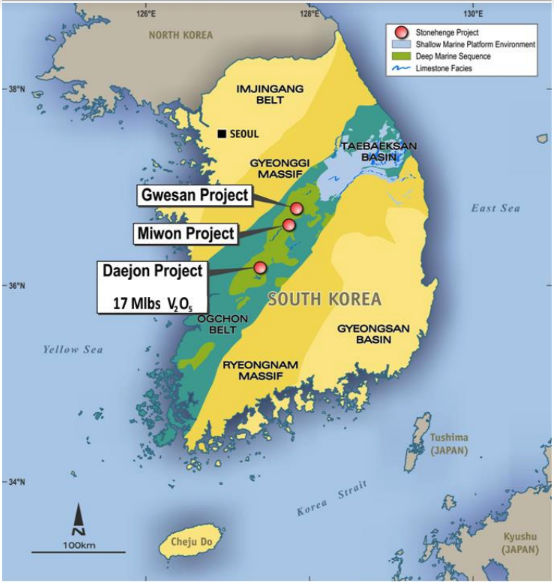Here are the top three factors that could see Protean take off

Pic: Bloomberg Creative / Bloomberg Creative Photos via Getty Images
Special Report: As other companies scramble to become vertically-integrated battery monopolies, Protean Energy is one of the few ASX stocks which already has the mine, the battery and the distribution network in place.
And as vanadium prices rise and Protean Energy (ASX:POW) continues to gather a growing portfolio of IP, one researcher has identified three key opportunities where Protean can outrun their rivals.
-
Metallurgy
At the base of Protean’s business is the vanadium/uranium deposit they’re developing at Daejon, South Korea.
It’s owned via a 50:50 partnership with KOSDAQ-listed DST Company and has a large, shallow resource of 76 million tonnes (Mt) at 3,000 ppm vanadium pentoxide and 110 parts per million (ppm) of triuranium octoxide (U3O8).
That’s a total of 490 million pounds of the former and 18 million pounds of the latter.
Independent Investment Research says the key opportunity at Daejon is to develop and optimise a cost-effective processing route for the Daejon black shale deposits.
“The deposit hosts a large vanadium-uranium resource which should be sufficient for a long-term operation. The company has access to the black shale metallurgical IP and pilot plant of KIGAM,” the report said.
“Successful outcomes from this work should leave Protean with a valuable, strategic asset, with the potential to supply South Korea’s vanadium and part of the uranium needs.”
After updating the resource in September, it is now working on pilot plant metallurgical testwork including ore beneficiation and process optimisation.
Furthermore, the “stable, infrastructure rich jurisdiction” and end users keen to take any vanadium and uranium produced by a future operation are strong benefits to working in South Korea, the report said.

-
Battery development
At the other end of Protean’s business is the modular vanadium redox flow battery (VRFB) which uses a technology they’ve dubbed the ‘V-KOR’.
The battery division is run through a 60 per cent-owned subsidiary called KORID and it has pilots running in South Korea and Australia.
Where most ASX battery metal companies are still setting up their mines and buying battery IP, Protean already has a functional battery.
The Korean Institute of Energy Technology Evaluation and Planning (KETEP) is trialling a 25 kilowatt (kW) stack as part of a 1 megawatt battery test, and a factory in Perth is also trialling a 25kW battery.
“The key opportunity for V-KOR is to produce a relatively low cost, high energy density and high energy transfer battery using the proprietary battery stack IP that will give the company an advantage should the VRFB markets develop as forecast,” the Independent Investment Research report said.
“This also presents technology licencing opportunities.”
The V-KOR battery has been under development for some 10 years.
Protean says the Perth field test has been successful so far, while the KETEP test is expected to significantly cut the costs of battery production through modifications including making the battery stack smaller and cheaper and developing higher density electrolytes.
-
Value return for shareholders
It’s early days yet, but Independent Investment Research says the Daejon project has the potential to develop into a valuable asset which will give Protean options on how to return value to shareholders.
“These could include developing the asset, selling a stake or else selling the complete asset,” it said.
Once Protean gets the project to production, the outlook for the commodities is excellent.
The report noted the strong demand for vanadium, partly driven by batteries, for the foreseeable future and said some are seeing improvements in the uranium market as well after a long bear market.
“Increase in [uranium] demand will be driven by new power generation, with about 240 nuclear reactors under construction or planned globally, and over 300 new reactors proposed,” it said.
The project is also a national strategic asset for South Korea and has strong backing from state institutions such as KETEP and KIGAM.
The county currently imports all of its annual requirements of 9.5 million pounds vanadium a year largely in steel production. South Korea the sixth largest steel producer globally.
On the uranium front, South Korea currently has 24 nuclear reactors and is planning another 21.
It imported 4,730 metric tonnes of uranium mtU in 2017, and this expected to rise to 5,300 metric tonnes by 2020.
- Subscribe to our daily newsletter
- Bookmark this link forsmall cap news
- Join our small cap Facebook group
- Follow us on Facebook or Twitter
Protean Energy is a Stockhead advertiser.
This advice has been prepared without taking into account your objectives, financial situation or needs. You should, therefore, consider the appropriateness of the advice, in light of your own objectives, financial situation or needs, before acting on the advice. If this advice relates to the acquisition, or possible acquisition, of a particular financial product, the recipient should obtain a disclosure document, a Product Disclosure Statement or an offer document (PDS) relating to the product and consider the PDS before making any decision about whether to acquire the product.
UNLOCK INSIGHTS
Discover the untold stories of emerging ASX stocks.
Daily news and expert analysis, it's free to subscribe.
By proceeding, you confirm you understand that we handle personal information in accordance with our Privacy Policy.







